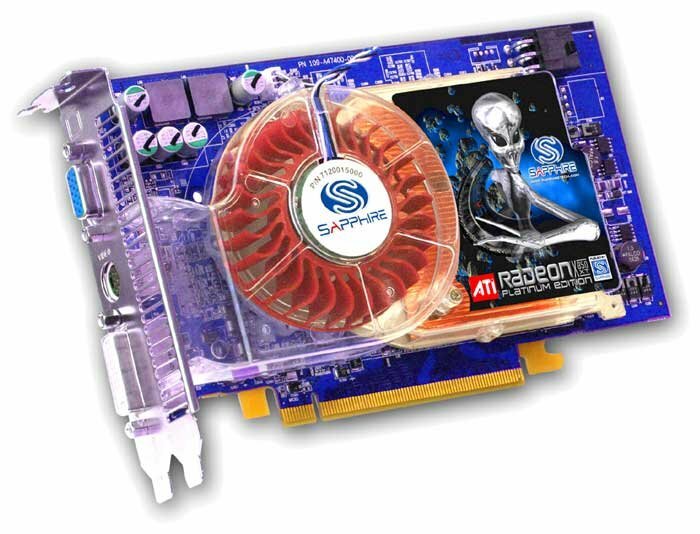Currently, the Canadian company ATI Technologies is doing more than successful – its products, thanks to a competent marketing policy, are more popular than ever. The new generation video adapters based on the RADEON X800 graphics processor, although with some difficulties, are available for purchase both in retail stores and as part of ready-made systems from manufacturers such as Dell and HP. These solutions offer excellent performance, in many cases surpassing the GeForce 6800 Ultra and GeForce 6800 GT in this parameter, however, ATI does not stop there – today it announces new graphics processors belonging to the RADEON X850 and RADEON X800 families.
ATI attacks the high-performance market
If we are talking only about desktop graphics, then, according to Mercury Research, for the third quarter of this year, ATI Technologies is the leader in this segment – it owns 55% of the market, versus 42% of its main competitor – NVIDIA. This situation is largely due to the presence in ATI’s arsenal of a number of competitive solutions, in particular, those related to the middle class. The families of video adapters RADEON 9800, RADEON 9600, RADEON X600, RADEON X700 intended for use on AGP and PCI Express platforms, respectively, are quite affordable for buyers with an average budget and have a good level of performance that allows you to comfortably play even the most modern games, such as FarCry, Half-Life 2 and others. For comparison,
However, despite the obvious success of the RADEON 9800- / 9600- / 9200 series, as well as the RADEON X600 and RADEON X300, ATI is not doing as well on the high-end market as the management of the Canadian company would like. According to data from Mercury Research, NVIDIA Corp. recently announced that it was able to ship approximately 1.5 million high-end DirectX 9.0 chips during the third quarter of this year, representing 64% of all high-end chips shipped this quarter. In comparison, ATI Technologies shipped approximately 800,000 DirectX 9.0-like GPUs, which is 36% of the total market. In the previous quarter, NVIDIA’s share was only 26%. Among 63.8 million solutions of the middle and entry-level DirectX 9.0 video processors, the market share controlled by NVIDIA was also slightly larger compared to ATI: 51% versus 49%,
Different types of high-performance solutions: Differentiate!
To get a clear idea of what the numbers published by Mercury Research actually consist of, let’s turn to the lead analyst at the company at Cave Creek, Arizona: “At this stage, Mercury’s calculations for DX9 and DX9c class graphics accelerators are based on transistors and does not attach importance to price or performance.All products with more than 100 million transistors are considered high-end solutions.This methodology is used in most of the current research, the results of which are NVIDIA.This system was developed to calculate the number of DX9-compatible solutions the first generation from both NVIDIA and ATI, for example, video adapters belonging to the GeForce FX 5x and RADEON 9500/9700 lines, “said Dean McCarron, chief analyst at Mercury Research.
Mercury Research’s definition of a high-end GPU is somewhat different from that of the mainstream media and computer enthusiasts. Usually, the media and enthusiasts consider the two main criteria for determining the positioning of a product in the market, price and performance. At present, the price range of $ 399 – $ 499 is occupied by such products as NVIDIA GeForce 6800 GT / Ultra and ATI RADEON X800 PRO / XT. Do not forget about the GeForce 6800, 6800 LE, as well as the RADEON X800 SE, these products have performance at the level of the previous top solution RADEON 9800 XT from ATI and occupy the price niche with the range from $ 250 to $ 300.
The following NVIDIA products consist of over 100 million transistors and are shipped in bulk quantities: GeForce FX 5900 XT, GeForce PCX 5900, GeForce FX 5900, GeForce FX 5900 Ultra, GeForce 5950 Ultra, GeForce 6600, GeForce 6600 GT, GeForce 6800 LE, GeForce 6800, GeForce 6800 GT and GeForce 6800 Ultra. Such solutions as GeForce 5900 and 5900 Ultra, with a low degree of probability, are also officially supplied by NVIDIA. The GeForce 5900 XT and GeForce 6600 GPUs are generally considered mid-range GPUs due to their performance, which is close to that of the ATI RADEON 9600- and X600- series. It should be noted that these chips have 75 – 80 million transistors.
And here is the list of ATI chips, consisting of more than 100 million transistors: RADEON 9800 SE, RADEON 9800, RADEON 9800 PRO, RADEON 9800 XT, RADEON X800 SE, RADEON X800 PRO, RADEON X800 XT, RADEON X800 XT Platinum Edition. However, the RADEON 9800 SE video adapter should be considered a mid-range solution, since the speed shown by this product is close to that of the RADEON 9600 XT. Looking at the abundance of graphics processors from ATI and NVIDIA that fit the definition of ‘high-end’, we can conclude that the method for determining the positioning of a graphics chip from Mercury is not ideal. Probably a more important criterion would be the performance in a certain popular test, or the number of operations per second, or the price.
Nevertheless, even with such an imperfect methodology, it is safe to assume that NVIDIA Corp. and its GeForce 6800 chips, one way or another, have a larger market share than ATI and RADEON X800. This, as well as the unprecedented high growth in sales of high-end graphics cards in 2004 (about 100% according to Tul Corp. and more than 10% according to ASUSTeK Computer) to a certain extent influenced ATI Technologies’ decision to significantly expand the RADEON X800 line. aimed at the market of expensive and relatively expensive graphics accelerators.
VPU Evolution: ATI Strategy
ATI Technologies’ strategy in the desktop graphics market is often the following: the company releases a new graphics processor and a number of video adapters based on it, and then, some time later, its successor is born, which usually has the same architecture, but thanks to the refinement of the technical process , capable of operating at a higher frequency, as well as a less powerful brother, specially designed to conquer the lower market segments. Thus, ATI’s product line is constantly updated, and the company does not have to spend a lot on it.
There is no need to look far for examples, it is enough to recall such successful modifications of the RADEON 9800 PRO and RADEON 9600 PRO as the RADEON 9800 XT and RADEON 9600 XT. The graphics processors R360 and RV360, which formed their basis, were practically no different from their predecessors, the R350 and RV350, respectively. However, they could run at a higher frequency, which allowed ATI Technologies to announce two new products with higher performance than previously. Sometimes ATI Technologies also produces GPU line splitting, in which one VPU is replaced by two different ones intended for different market sectors.
Let’s recall the RADEON 9700/9500 PRO. Initially, the ATI R300 chip was used to produce both high-end cards – RADEON 9700 PRO, and inexpensive variants – RADEON 9500/9500 PRO. In the latter version, the cards were equipped with memory with 128-bit access, and some of the pixel pipelines, in the case of the RADEON 9500, were disabled. As you know, it is not profitable to start up a complex and expensive graphics processor for the production of mid-range cards, however, ATI did not have much choice – the company needed massive and sufficiently productive solutions; in addition, some of the crystals still came out defective – for example, some of the pixel pipelines did not work in them.
Why not use these crystals instead of throwing them away? In the case of the RADEON 9700/9500 series ATI Technologies did just that. But time passed the technological process gradually became more and more close to perfection, and the number of defective crystals decreased, and, consequently, there was not enough of them. Then the company decided to separate the upper and middle class lines, releasing separate GPUs for them. This is how the ATI RADEON 9800 PRO and ATI RADEON 9600 PRO were born.
Thus, it is obvious that ATI associates the emergence of new graphics architectures with the emergence of new high-end VPUs, and while productive chips are attacking in the segment of expensive accelerators, a special team at ATI Technologies creates something more accessible to a typical user of video cards on the basis of the existing high-end hardware. … This strategy has both advantages and disadvantages. On the one hand, ATI has a lot of time to adapt its graphics architecture to the needs of each individual market: high-end, mainstream, entry-level, getting a relatively inexpensive but sufficiently productive chip for each segment.
On the other hand, it is obvious that it will take a lot of time to adapt the architecture and design specific chips for the mainstream and entry-level part of the markets, which will not allow users to those who spend about $ 100 on video cards get the same level of capabilities as those who pay $ 400 – $ 500. However, as the practice of the last couple of years shows, users of ATI products can choose from a fairly dense line of products in the price range of $ 150 – $ 500 graphics accelerators with practically the same functionality within 4-6 months after the appearance of the new architecture.
ATI Expands High-End PCI Express Line
Today we will talk about the replenishment of ATI’s line of PCI Express graphics processors, namely the new RADEON X850 processor, which is intended to replace the RADEON X800 in the sector of the highest-performance solutions for the PCI Express platform, moving it slightly lower. Now the assortment of ATI chips designed for the PCI Express platform has acquired the following form:
RADEON X850
RADEON X800
RADEON X700
RADEON X600
RADEON X300
These five VPU families cover the entire range of desktop solutions, from the cheapest entry-level graphics cards to ultra-high-performance monsters over $ 500.
As usual, several video adapters based on RADEON X850 will be produced at once, as was the case with RADEON X800. The older model, ATI RADEON X850 Platinum Edition, topping the line, will have clock speeds of 540/1180 MHz (core / memory), 16 pixel pipelines and a recommended price of $ 549. The less expensive RADEON X850 XT will differ from it only in the frequencies at 520/1080 MHz and the recommended price at $ 499.
The video adapter RADEON X850 PRO will stand somewhat apart, as in the RADEON X800 PRO; the number of pipelines in this case will be reduced to 12, although the clock frequencies will remain the same as in the model with the XT index. Besides, the junior model priced at $ 399 will not be equipped with two DVI connectors and will not be equipped with VIVO functions, like the RADEON X800 XT Platinum Edition and RADEON X850 XT.
The RADEON X800 series will also undergo significant changes. To all appearances, the RADEON X800 XT Platinum Edition and X800 XT are getting ready to become a thing of the past, their place on the market will be taken by the new RADEON X850 XT PE and RADEON X850 XT. In addition, ATI is preparing to respond to the products of the GeForce 6800 GT and GeForce 6800 class with the new RADEON X800 XL and RADEON X800 products. RADEON X800 XL, with a recommended price of $ 349, has 16 pixel pipelines and operates at 400/1000 MHz; RADEON X800, costing $ 249, will carry 12 pipelines on board, clock frequencies will be 400/700 MHz, and the video memory capacity will be reduced to 128 MB. Thus, the RADEON X8 (X800 / X850) family will look like this:
Click to enlarge
The new RADEON X800 XL and RADEON X800 cards will have a new graphics processor – R430, not R423. The new version of the RADEON X800 will be manufactured using a 0.11-micron technical process, which will reduce the level of heat dissipation and equip the cards with a simpler cooling system. Judging by the currently available images provided by ATI Technologies, the connector for connecting an additional power supply in the new RADEON X800 will also disappear. Thus, what happened in due time with the RADEON 9700/9500 is happening now with the RADEON X800 – one product line will be split into two new ones, and each of these new lines will use its own graphics processor.
But back to the RADEON X850. As expected, the capabilities of the new VPU actually remain the same as those of the RADEON X800. The new chip is still based on the latest generation high-performance 16-pipe architecture from ATI Technologies, which allows to achieve the highest level of performance, especially in heavy gaming modes. All the peculiarities of this architecture were described in detail in our article devoted to RADEON X800.
In fact, the RADEON X850 differs from the RADEON X800 only in its improved technical process, which allows reaching higher frequencies, as well as in the presence of improved power-saving functions. Besides, this time ATI has developed a really effective and powerful cooling system for new video adapters based on RADEON X850, but more on that later. All the technologies embodied in silicon in the RADEON X800 are naturally present in the RADEON X850. These technologies include SMARTSHADER HD, SMOOTHVISION HD, HyperZ HD, and VIDEOSHADER. New algorithms for compression of 3Dc normal maps are also supported, allowing you to increase the image detail by overlaying more complex relief.
PCI Express Today: VPU Mecca or Wrong Step?
Although the prevalence of systems equipped with the PCI Express bus is still relatively low, which seriously limits retail sales of PCI Express x16 adapters, ATI is making a serious bet on this platform. What is the reason for this? First of all, by selling graphic cards as part of ready-made systems. Slide:
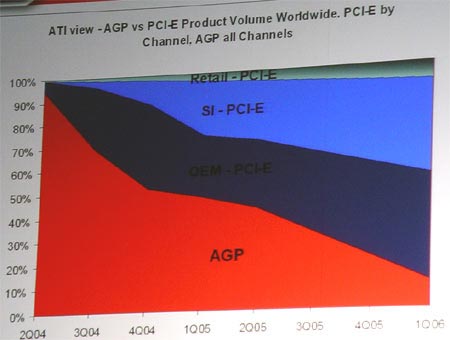
According to ATI’s vision, which supplies about 100% of PCI Express x16 graphics cards to companies like Dell, HP, etc., by the beginning of the fourth quarter of 2004, the share of PCI Express video cards had grown to just under 50% of the entire VPU range supplied by ATI. By the beginning of the first quarter of the next calendar year, more than 50% of ATI’s graphics chips will be dedicated to PCI Express computers.
In general, the relatively rapid spread of PCI Express among assemblers of ready-made systems is quite understandable – all new and advertised platforms from Intel, the main supplier of microprocessors, use a new bus to connect the components of a computer system into a single whole.
However, it is generally accepted that only a small number of off-the-shelf PCs use expensive graphics cards, and therefore ATI’s idea of offering 5-9 graphics cards in the upper price range ($ 249 – $ 549) is hardly a good one. Nevertheless, with the advent of PCI Express chipsets for AMD64 processors, which are popular among computer players, the demand for PEG x16 video cards will undoubtedly grow, and, therefore, ATI will be in a rather advantageous position for itself.
However, there are a huge number of AGP systems, the owners of which are planning to upgrade the graphics accelerator, as well as a large number of system integrators who supply expensive AGP computers today. Considering that ATI performed slightly worse than NVIDIA on the field of high-performance graphics accelerators with this interface this year, the new RADEON X850 and X800 families are unlikely to bring serious dividends to the Canadian company. Thus, the following conclusions can be drawn:
In a situation where few sellers and system integrators can get the GeForce 6800 Ultra for PCI Express, with the release of the RADEON X850 ATI’s positions will be strengthened in the most serious way. Since NVIDIA and its partners have hardly begun mass deliveries of GeForce 6800 PCI Express and NV41-based graphics solutions priced at about $ 300, ATI’s position in this segment will again be confident.
ATI’s positioning in the retail market of expensive AGP 8x graphics cards with the release of RADEON X850, RADEON X800 will not change. The competitor in the face of NVIDIA has no more productive solutions than the GeForce 6800 Ultra, which is often inferior to its rival RADEON X800 XT Platinum Edition; however, ATI has not yet shown the possibility of wide distribution of RADEON X800 XT video cards, a competitor to the GeForce 6800 GT, one of the best-selling products among expensive video cards.
Today, the lion’s share of high-speed graphics cards sold through retail outlets are for AGP systems. However, in the future, this situation will change under the pressure of the PCI Express platform. A shift in customer demand for expensive PCI Express cards should be expected after powerful new platforms appear on the market, especially those designed for processors with AMD64 architecture. It is, however, rather difficult to name a specific timeline for switching customer attention, as they will vary from mid-January to mid-February, or even shift into the more distant future.
Taking into account the above, it is easy to guess that the main task of ATI, against the background of the absence of new products from the GeForce 6800 series and more powerful ones, is to stimulate the demand for video cards with the PCI Express interface, because it is in this environment that ATI has the most noticeable advantage over its competitor. Now that the market prospects of the new RADEON X850 and X800 have become clearer, let’s move on to the hero of today’s review: VPU RADEON X850 XT Platinum Edition.
RADEON X850 XT Platinum Edition: inspires respect
All high-performance solutions developed by ATI Technologies have always had compact dimensions and a modest cooling system. Of course, some manufacturers used their own designs, but reference coolers from ATI have never been massive. It seems, however, that this approach is in the past. The RADEON X850 Platinum Edition that arrived at our laboratory looks very impressive. For the first time in our practice, a reference card from ATI is equipped with a massive cooling system that takes up two slots and throws hot air out:

Cooling system
The blover of the cooling system takes air from the PC case, drives it, or rather, pulls it through a copper heatsink, which gives off heat generated by the VPU crystal and memory chips, and throws it out through the grill in the mounting plate. Perhaps the intake of cold air from the outside of the case and blowing it off the heatsink would have been more effective, but ATI engineers decided to do exactly as described in the previous sentence. We have dismantled the RADEON X850 XT Platinum Edition cooling system to take a closer look:
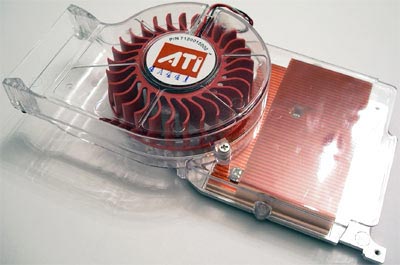
The design looks very clever and simple at the same time. On a massive aluminum base there is a radiator milled from a single piece of copper – no soldering or gluing of fins is observed here. Blover, unlike NVIDIA solutions, has a tachometer, which, in theory, allows for more flexible control of the impeller rotation speed. There are no technological refinements such as heat pipes, which will have a positive effect on the price of the final product.
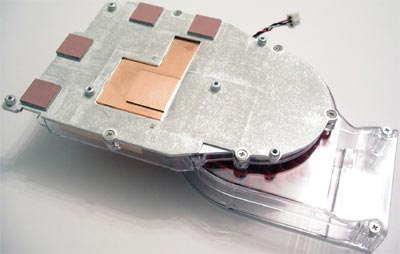
As you can see, the new cooling system developed by ATI Technologies is fastened at six points, so there is no risk of poor fastening at all. The aluminum base has a shaped slot through which the copper heatsink contacts the surface of the VPU die by means of a special square protrusion. In the place of contact there is a thick dark gray thermal paste, usual for ATI cards. As practice has shown, this paste is of a sufficiently high quality so as not to worry about the efficiency of the heat sink and thermal resistance in the area of contact between the heatsink sole and the processor crystal.
In the area of memory chips on the base of the cooler there are also square protrusions, to which rather thick elastic thermal pads of a flesh-pink color are glued. Their effectiveness is questionable. In such cases, NVIDIA uses special fiber spacers impregnated with thermal paste, however, coolers developed by this company are very carefully fitted to the PCB, which makes it possible to get by with rather thin spacers. In this case, such a careful manufacturing is not observed, therefore, the use of thick rubber-like gaskets is quite justified – you can be sure that the memory chips will not be left without cooling.
The fact that the memory is cooled is very encouraging, because the memory chips in the RADEON X800 line were not cooled at all. Those from the memory chips that are located on the back of the printed circuit board, They are also equipped with a kind of radiator – an L-shaped aluminum plate, which also serves as a fastening element for the cooling system. The thick spring steel bracket previously found in the VPU area is missing – the aforementioned plate now provides the fixing rigidity.
Overall, the new cooler gives the impression of simplicity and efficiency.
We’ll find out how efficiently and quietly such a system works later, but for now let’s see how similar the PCBs of RADEON X800 and RADEON X850 are, and also show the “face” of the hero of our today’s review.
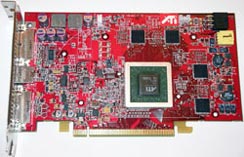
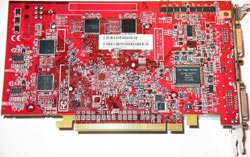
PCB design
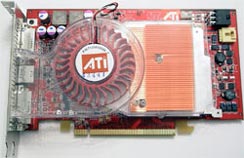
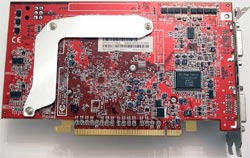
The card practically does not differ from the usual RADEON X800 XT PCI Express, which is not surprising – the old PCB design works well, why waste time and resources on developing a new one? Of greatest interest here is the GPU crystal, on which the R480 inscription is clearly visible, as well as the PCI Express logo:
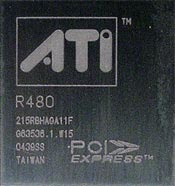
This GPU was released during the 39th week of 2004, that is, at the end of October. Thus, its age is approximately one month, which means that ATI most likely has no problems with the R480. The PCB contains 8 Samsung GDDR3 memory chips with an access time of 1.6 nanoseconds. Such fast memory is necessary, because its operating frequency in the RADEON X800 XT Platinum Edition is 1180 MHz, which is only 20 MHz lower than the nominal frequency for such chips.
The memory is still 256 MB, although the processor itself can handle up to 512 MB of video memory. Currently, this amount of video memory is absolutely not in demand; the presence of 512 MB of memory on board the RADEON X850 Platinum Edition would only significantly raise the price of an already expensive product without affecting its capabilities and performance in any way.
As for the configuration of connectors, it is the most modern here – the card is equipped with two DVI-I connectors, which allows you to connect two LCD monitors to it via a digital interface at once. The second digital output is served by a Silicon Image Sil1162 DVI transmitter. However, this configuration is not new for ATI – it is also used in the PCI Express version of the RADEON X800 XT.
Additional power is supplied to the card through a six-pin connector, which has become the standard for powerful PCI Express video adapters that require such power. While the power supplies are not equipped with such a connector, therefore, you have to use a special adapter, but with the further growth in the popularity of the PCI Express platform, the new PSU models will undoubtedly acquire a separate power line equipped with such a connector.
Now let’s see how well the new product performs in practice, but first, let’s find out if the new cooling system is so effective and does it torment the user’s ears with a piercing noise, as the GeForce FX 5800 Ultra did in its time?
Noise, acceleration and 2D quality
The very first launch of the system with the RADEON X850 XT Platinum Edition card installed made us remember the legendary GeForce FX 5800 Ultra – the fan working at full speed made a lot of noise, and the noise was quite high-frequency, which made it even more annoying. At the same time, the presence of a dull casing played a bad joke – apparently, it functioned as a resonator, further amplifying the noise emitted by the fan, and giving it a plastic tint. It was very unpleasant to be near the RADEON X850 XT Platinum Edition at that moment.
Fortunately, this nightmare lasted no more than 5 seconds, after which the card reduced the fan speed, and the noise level decreased significantly, although it did not disappear at all. Later on, the fan continued to run at reduced speeds, despite the load we put on the card during testing. During the entire testing period, the card never raised the fan speed, so the noise level emitted by the new cooling system from ATI can be considered moderate. In addition, our test platform is a motherboard mounted on a soft base; to facilitate the process of testing numerous video cards, we do not install it in the case, unlike ordinary users. In the case of an ordinary personal computer, the noise from a running RADEON X850 XT Platinum Edition will be even lower.
In this way, 2D quality turned out to be traditionally good – at all resolutions, including 1600x1200x85 Hz, the picture was crystal clear and free from blur.
Test platform configuration and test methods
Since the new product is equipped with a PCI Express interface, and we have at our disposal almost the entire range of video cards for this platform, we decided to use only it. The test platform was configured as follows:
Intel Pentium 4 560 CPU (Socket 775, 3.60GHz, 1MB L2 cache);
Intel Desktop Board D925XCV;
1GB DDR2 PC2-4300 (533MHz) SDRAM (Micron Technology, 2x512MB);
Samsung SpinPoint SP1213C HDD (Serial ATA-150, 8MB buffer);
Creative SoundBlaster Audigy 2.
The following software was installed on the platform:
Microsoft Windows XP Pro SP2, DirectX 9.0c;
ATI CATALYST 4.12 beta; CATALYST 8.08 для RADEON X850 XT PE
NVIDIA ForceWare 66.93.
We used the following games for testing:
3D First Person Shooters:
Call of Duty: United Offensive;
Doom III;
Unreal Tournament 2004;
Halo: Combat Evolved;
FarCry;
Painkiller;
Counter Strike: Source;
Half-Life 2.
3D third-person shooters:
Splinter Cell: Pandora Tomorrow;
Prince of Persia: Sands of Time;
Max Payne 2: The Fall of Max Payne.
Simulators:
IL-2 Sturmovik: Aces in the Sky;
Lock On;
Colin McRae Rally 04.
Strategy games:
Command & Conquer Generals: Zero Hour;
Perimeter.
Semi-synthetic benchmarks:
Aquamark3.
Synthetic benchmarks:
Futuremark 3DMark03 build 350;
Futuremark 3DMark05 build 110.
As you can see, we have a small replenishment: for the first time in the review of a new video adapter, we use the recently released masterpiece from Valve – Half-Life 2, as well as a new test suite from Futuremark – 3DMark05. In addition, we have replaced the online shooter Call of Duty with an improved version called Call of Duty: United Offensive. The new version has significantly improved the graphics, and added features that make the gameplay more interesting – in particular, it became possible to control tanks, armored personnel carriers and other equipment from the Second World War.
In all cases, the graphics quality was set to the highest possible level, the same for ATI and NVIDIA cards. In the latter case, the Anisotropic mip sample optimization has been disabled. It was decided to abandon theoretical tests, since the RADEON X850 XT Platinum Edition is, in fact, a faster version of the RADEON X800 XT, and these tests would not have shown anything new. Since the availability of the GeForce 6800 Ultra in the PCI Express x16 version leaves much to be desired, as well as because there is no such product in our laboratory today, we used the GeForce 6800 GT for comparison with the new product from ATI. Of course, this is not a completely fair comparison, because the GeForce 6800 GT is positioned at a lower level and costs $ 150 less.
OVERDRIVE 3: dynamic acceleration system in need of improvement
A year ago, together with the release of the RADEON 9600 XT and RADEON 9800 XT, ATI Technologies introduced to our attention the OVERDRIVE technology, which allows dynamic overclocking of a video processor. The first revision of this technology was not as successful as we would like: the technology did not work on a number of cards, and also gave an almost imperceptible increase in performance. With the arrival of the RADEON X850 XT and several other products, ATI is bringing back the OVERDRIVE feature under the name OVERDRIVE 3. This technology is expected to provide high performance gains due to more substantial overclocking, which does not cancel the warranty!
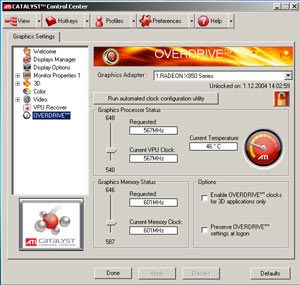
The new OVERDRIVE technology with a built-in auto-detect of the maximum overclocking frequency will increase the frequencies up to 648MHz / 1292MHz for the chip and memory, respectively. Perhaps these are not so high frequencies, but the gain is quite noticeable. In the event that your video card is overclocked, VPU recover will lower the frequencies to the nominal ones. The performance gains achieved with OVERDRIVE 3 should be much higher than previous dynamic overclocking technologies.
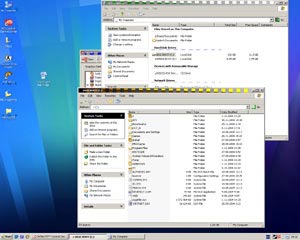
Unfortunately, at the moment, both the hardware and the software component of this technology do not allow working in dynamic overclocking mode even with a slight overclocking (overclocking to 567MHz / 1202MHz from the level of initial frequencies of 540MHz / 1180MHz cannot be called extreme, not is not it?). Artifacts appeared on the desktop, and FarCry presented a terrifying picture to our attention. Also, when we tried to run 3DMark05 and Doom III, we got the same result, and in addition to everything, the card froze repeatedly.
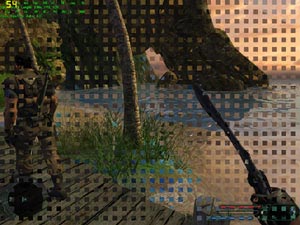
It seems to us that at this stage the problems with OVERDRIVE 3 are related to the BIOS version. The card is, in fact, a raw product with unsettled software. Perhaps the final product will be free of these problems, but prospective buyers should be aware of the potential problems that could arise with OVERDRIVE 3. To summarize, OVERDRIVE 3 is not a bad idea, although it should be noted that the expected performance gains will not be more than 5% – 6% in cases of OVERDRIVE activation. Do not forget that there is still work to be done on adjusting the normal functioning of this technology.
Game tests: Call of Duty: United Offensive
The new version of Call of Duty is more complex than its predecessor – it has some pretty nice special effects, although the game is still based on the Quake 3 engine. United Offensive is undemanding to the video adapter – all high-end cards demonstrate a speed of over 150 frames per second in it. …
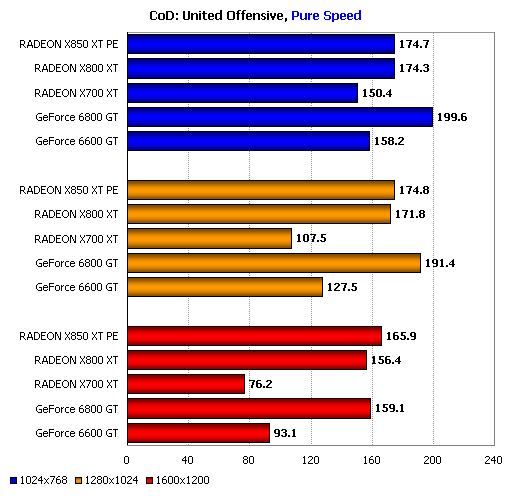
The results obtained in the first two resolutions should not be taken seriously – the game is clearly limited by the performance of the central processor. This barrier is different for ATI and NVIDIA cards, which shows some differences in the OpenGL driver, but it does exist. At 1600×1200, however, the main influence is already exerted by the performance of the video subsystem. GeForce 6800 GT and RADEON X800 XT show almost the same results here, however, as well as the new ATI RADEON X850 XT Platinum Edition.
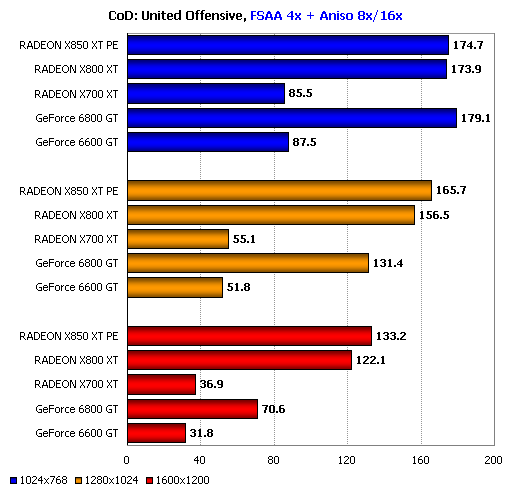
With full-scene antialiasing and anisotropic filtering enabled, the picture is somewhat different – at resolutions over 1024×768, ATI cards are in the lead. However, this is not surprising, since they always felt great in the so-called. heavy duty. The difference between the two older RADEONs is about 10 FPS, which does not look too noticeable against the background of general indicators in the region of 120-130 frames per second.
Game tests: Doom III
Doom III is an NVIDIA Conservation Area. The game is perfectly adapted to the architecture and OpenGL drivers created by this company.
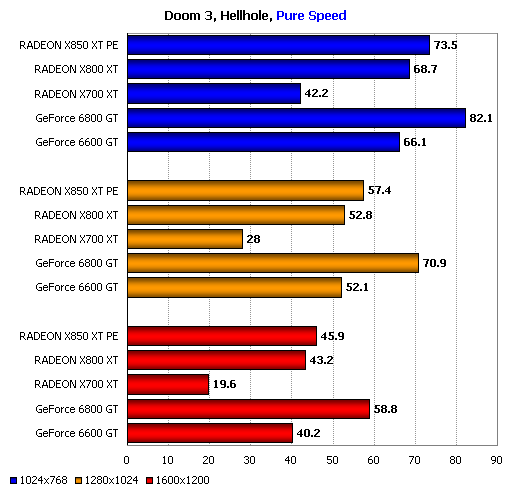
Here the GeForce 6800 GT leads in all resolutions. The new RADEON, despite the increase in clock frequencies, cannot outperform its rival, at least now. It remains to wait for the appearance of a new OpenGL driver from ATI Technologies.
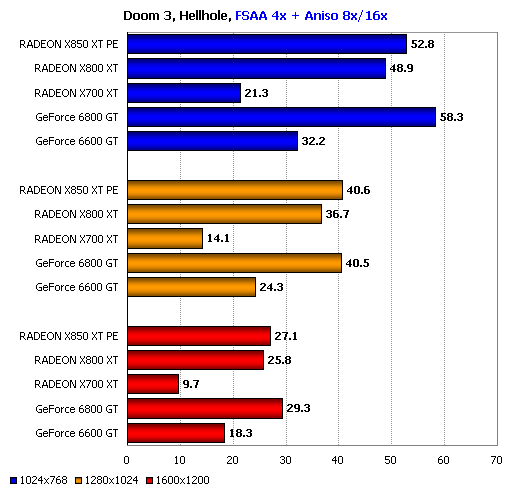
In Eye Candy mode, the situation does not look so hopeless anymore. Although the GeForce 6800 GT remains the leader, the RADEON X850 XT Platinum Edition manages to achieve the same result at 1280×1024 and come close to it at 1600×1200.
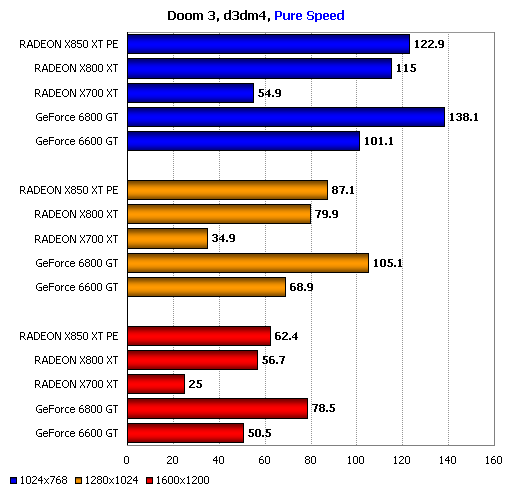
The second level of Doom III, used by us, does not contain monsters, as it is intended for multiplayer play. The indicators are higher here, however, on the whole, the picture is the same – the first place belongs to the GeForce 6800 GT. The RADEON X850 XT Platinum Edition slightly outperforms its predecessor, but naturally, there is no revolutionary leap in performance – the increase in frequency is not so great to achieve an impressive effect.
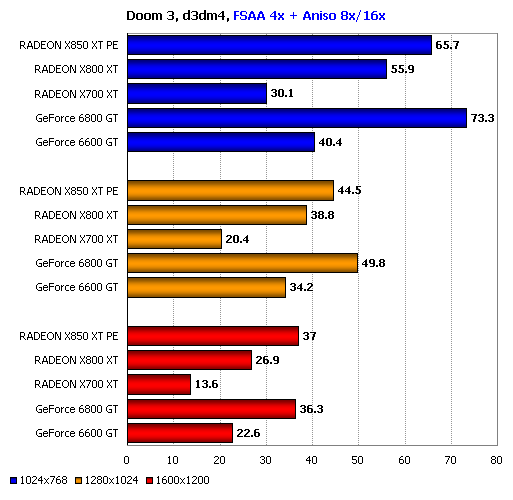
Unlike the Hellhole level, here the new product fails to reach the level of the GeForce 6800 GT, although at 1600×1200 it is very close to this.
Game tests: Unreal Tournament 2004
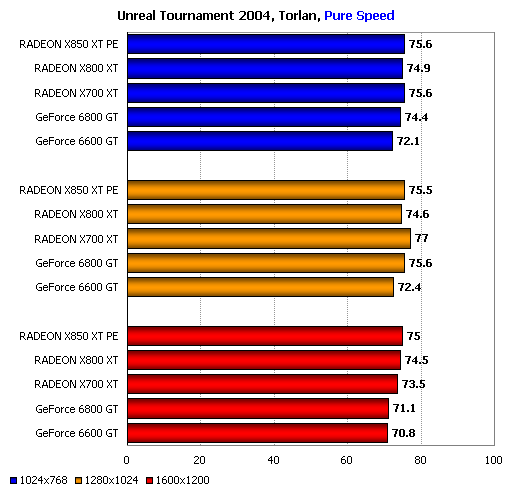
The latest version of Unreal Tournament can no longer be called a demanding new generation game. All modern high-end video adapters provide approximately the same level of performance, limited only by the speed of the system’s central processor. The above diagram, at least for the case of Intel Pentium 4 560, fully confirms this.
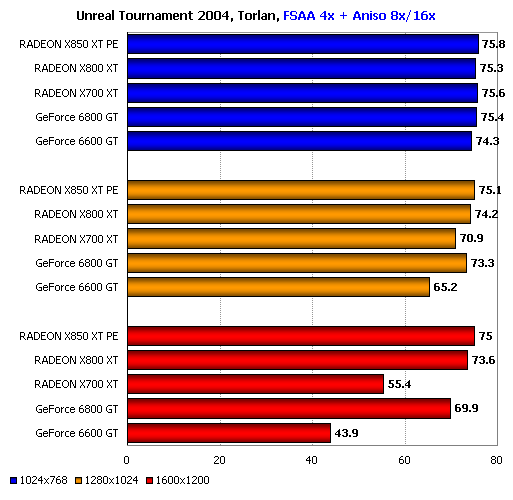
We don’t see much difference in the mode with enabled anisotropic filtering and FSAA, except for the 1600×1200 resolution, where the RADEON X850 XT Platinum Edition reaches the ceiling, while the GeForce 6800 GT lacks strength for this.
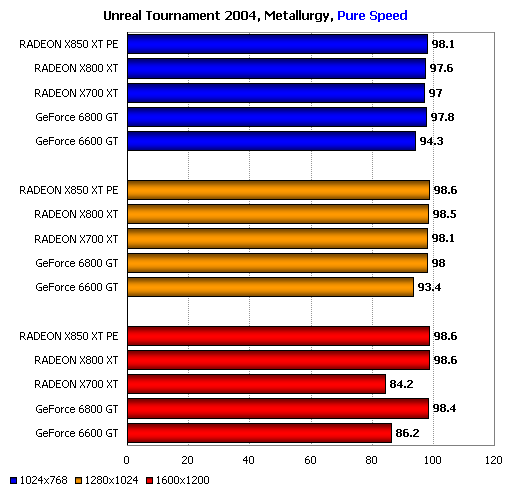
The Metallurgy level is less processor-dependent – here some difference is visible already at 1600×1200 in pure performance mode. However, it is demonstrated only by mid-range cards such as RADEON X700 XT and GeForce 6600 GT.
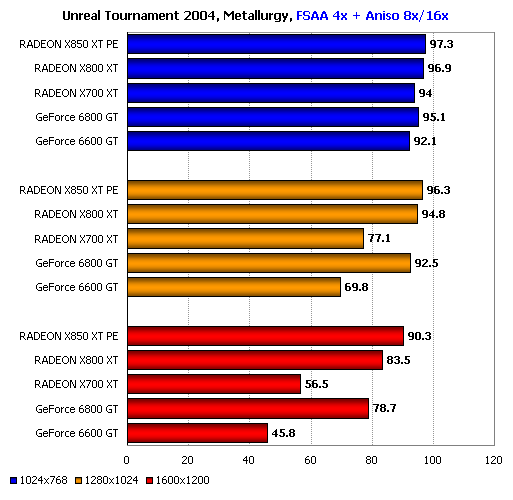
With full-screen anti-aliasing and anisotropic filtering enabled, the RADEON X800 / X850 cards slightly outperform the GeForce 6800 GT, but, again, this is noticeable only at 1600×1200.
Game Tests: Halo: Combat Evolved
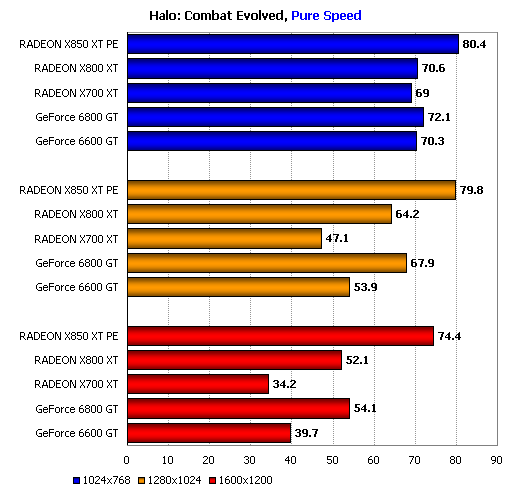
Halo is also difficult to call a masterpiece against the background of such monsters as Half-Life 2, FarCry and Doom III, however, the game is replete with pixel shaders, so it is quite suitable as a test tool. In this case, you can see a phenomenal performance gain in the RADEON X850 XT Platinum Edition, which makes it the leader. What caused this – we do not know, perhaps the answer lies in the new drivers provided to us along with the latest ATI Technologies card.
Game tests: Far Cry
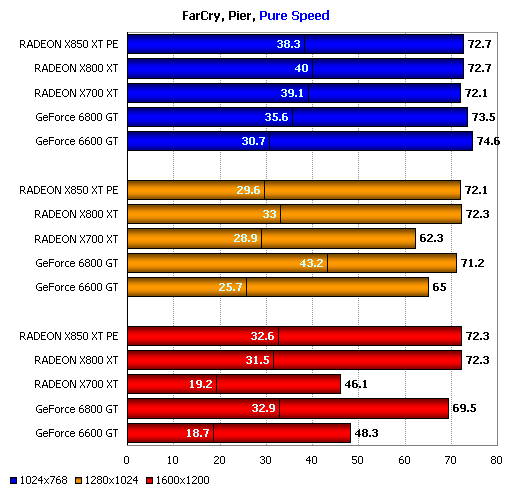
FarCry is one of the most modern and beautiful games, replete with beautiful textures and complex geometry, as well as a lot of pixel shaders, moreover, not simple ones. Nevertheless, the demo we recorded at the Pier level does not say anything in this case – all cards, with the exception of the GeForce 6600 GT, have reached the performance ceiling limited by the central processor.
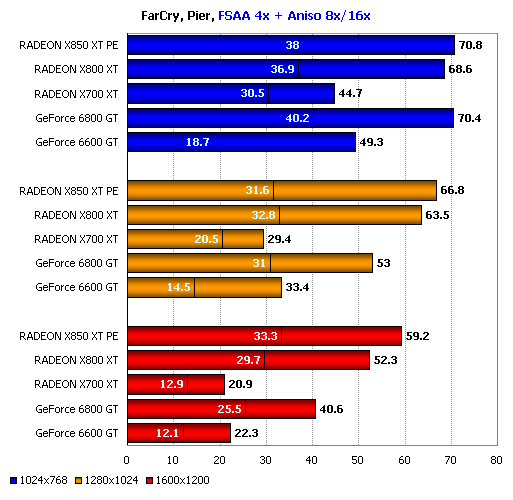
But in the eye candy mode everything is much more interesting – if in low resolution the GeForce 6800 GT and ATI cards of the highest level are practically on a par, then already in the resolution of 1280×1024 the advantage of the latter is revealed. Here the difference between RADEON X800 XT and RADEON X850 XT Platinum Edition is still small, but with further increase in resolution it grows and amounts to about 10%.
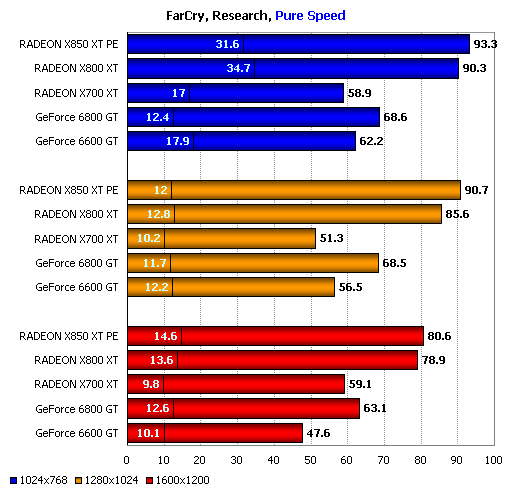
The entry made at the Research level has been replaced by a new, longer one. Now there is not only a walk in the cave, but also a run along the seashore. Accordingly, the results have also changed – the RADEON X800 / X850 cards significantly outperform the GeForce 6800 GT in all resolutions. But the difference between RADEON X800 XT and RADEON X850 XT Platinum Edition is again almost imperceptible.
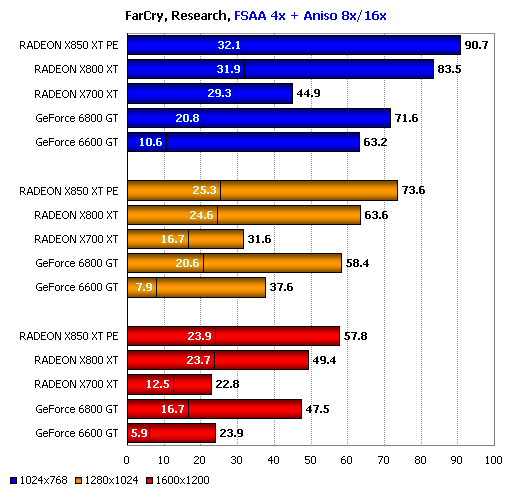
The simultaneous activation of full-screen anti-aliasing and anisotropic filtering greatly increases the load on the memory subsystem, and every additional megahertz counts. That is why the advantage of the new RADEON over its predecessor in this case is greater than in the previous one.
Game Tests: Painkiller
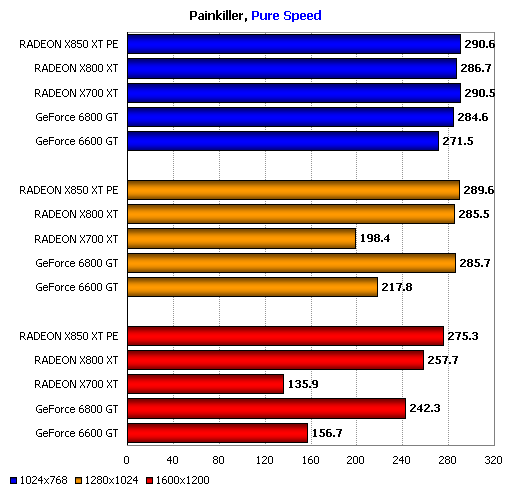
Painkiller is a very beautiful and quite complex, but very undemanding shooter. Modern cards show fps values of about 200-300 in it. The difference between them begins to appear only with a resolution of 1600×1200. The older RADEON models are the winners again. The new product again shows about 10% advantage over the RADEON X800 XT.
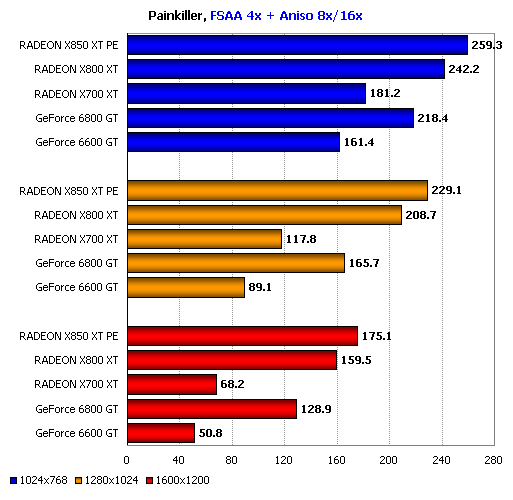
When tested with full-screen anti-aliasing and anisotropic filtering enabled, ATI Technologies cards increase their advantage, significantly outperforming the GeForce 6600 GT.
Game tests: Half-Life 2
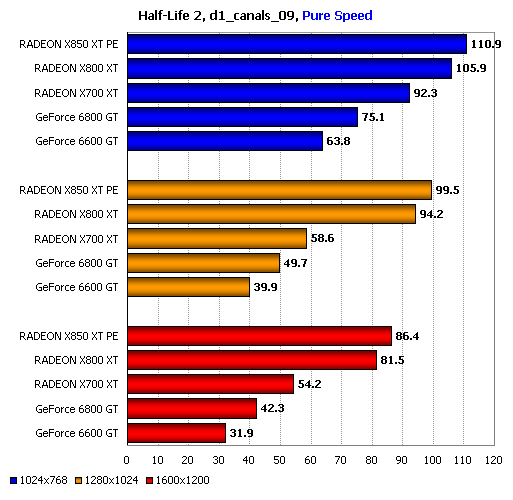
The first level of Half-Life 2 we are using contains vast bodies of water. In fact, its whole point is to travel in a hovercraft through an old abandoned canal system. Shaders imitating a water surface are rightfully considered one of the most complex, as they require intensive mathematical calculations, and it is precisely with such shaders that RADEON X800 cards cope best of all. In addition, in this case, we enabled the Reflect All mode, which further increased the load on the video adapter. The RADEON X850 XT Platinum Edition and RADEON X800 XT coped with the task perfectly, having won an unconditional victory over the GeForce 6800 GT.
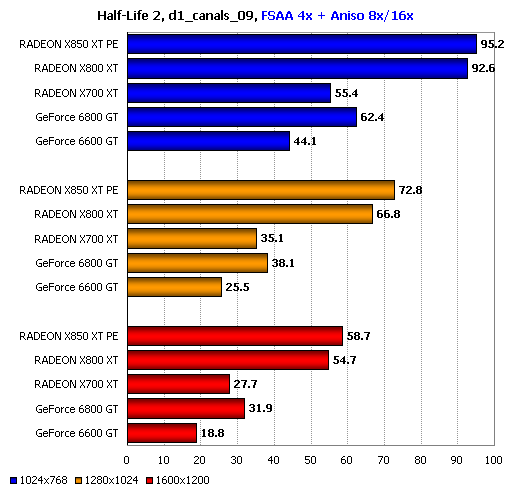
In Eye Candy mode, the advantage of ATI cards is further enhanced by adding extremely efficient algorithms to save video memory bandwidth in addition to the high speed of execution of complex pixel shaders.
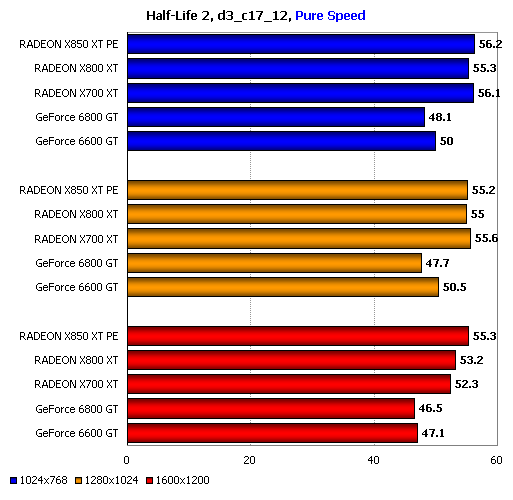
The second scene of Half-Life 2, used by us, is extremely processor-dependent, as it is a scene of a battle on the streets of City 17. The main load here falls on the central processor, which calculates the physical model, and all sufficiently fast video adapters, as a rule, demonstrate approximately the same results , especially on Intel Pentium 4 processors, which are inferior in speed to AMD Athlon 64 chips in Half-Life 2.
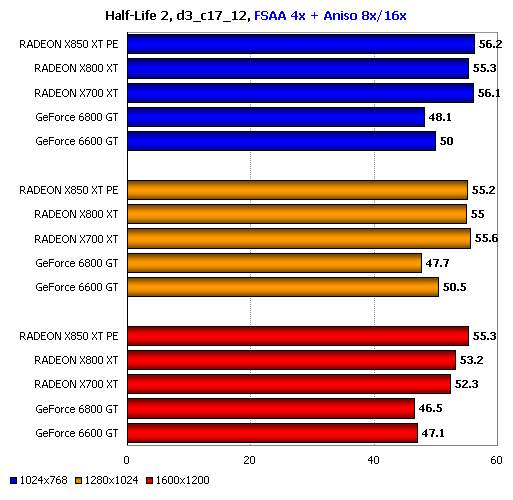
The same can be said about the eye candy mode – the difference between the cards of the highest level here is vanishingly small.
Game tests: Splinter Cell: Pandora Tomorrow
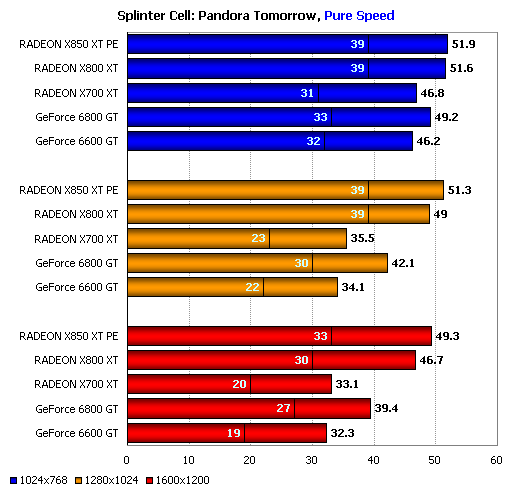
Splinter Cell: Pandora Tomorrow also loves the high processing speed of complex pixel shaders, as they are found at every turn in this game. At 1024×768 it is impossible to say who is the winner, however, already at 1280×1024 it is clear that these are RADEON X800 XT and RADEON X850 XT Platinum Edition. The difference between these two solutions is very small and does not even reach 10%.
Game tests: Prince of Persia: Sands of Time
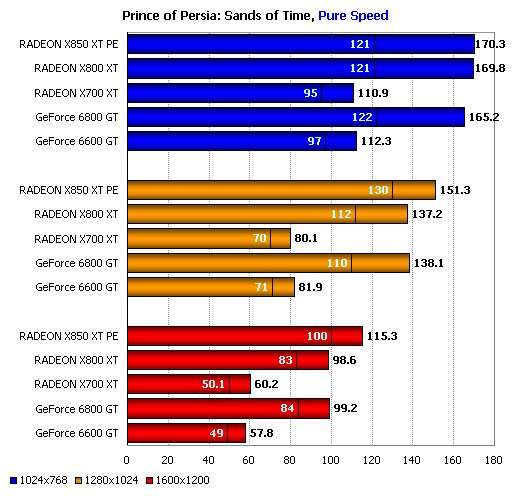
In Prince of Persia: Sands of Time, parity is observed between the RADEON X800 XT and the GeForce 6800 GT, however, the RADEON X850 XT Platinum Edition is in the lead. This is one of those cases when the new product shows a significant advantage over the RADEON X800 XT.
Game tests: Max Payne 2: The Fall of Max Payne
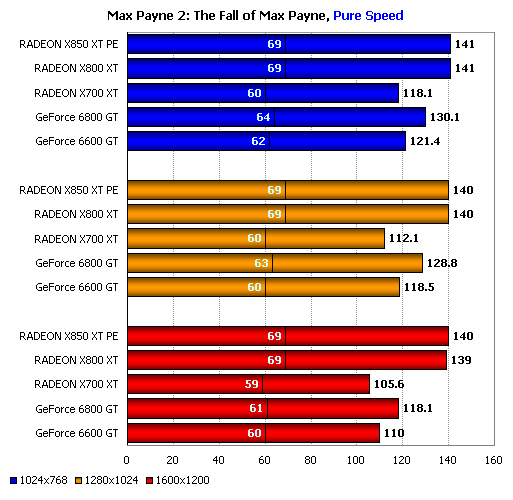
In Max Payne 2 in Pure Speed mode, both senior RADEON models reach the performance ceiling in all three resolutions. The game is already too easy for modern high-end cards. Let’s see how the situation will change if you enable full-screen anti-aliasing and anisotropic filtering.
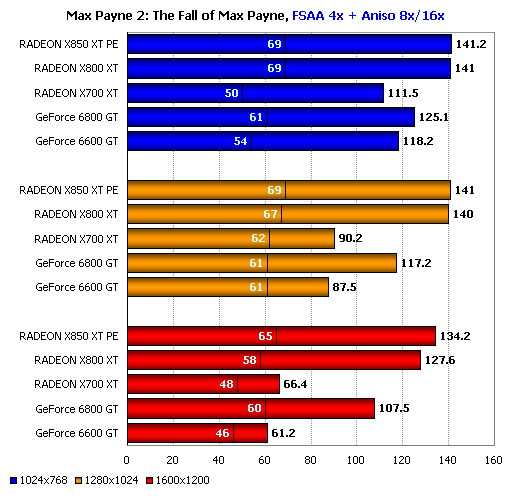
The situation is not changing much – both RADEON X800 XT and RADEON X850 XT Platinum Edition again run into the performance of the central processor, although at 1600×1200 the difference between these cards is already noticeable. As regards NVIDIA GeForce 6800 GT, it is logical that it lags far behind high-performance ATI cards in all resolutions.
Game tests: IL-2 Sturmovik: Aces in the Sky
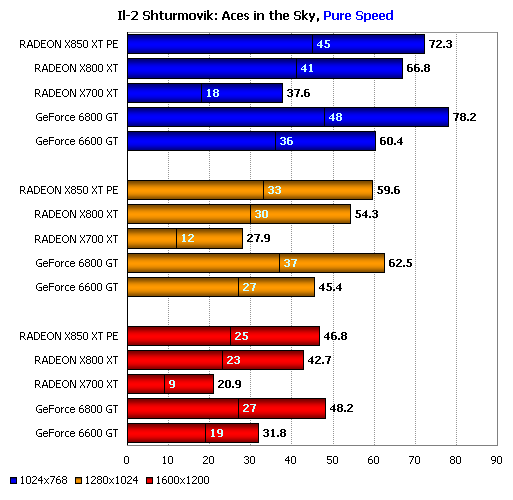
“Aces in the Sky” require both high texturing speed and fast work with pixel shaders from the video system. The former is better in the GeForce 6800 GT, while the latter is in the RADEON X800 XT / X850 XT PE. The brainchild of NVIDIA is slightly ahead of cards from ATI Technologies, but the increased frequencies allow the RADEON X850 XT Platinum Edition to keep approximately at the same level.
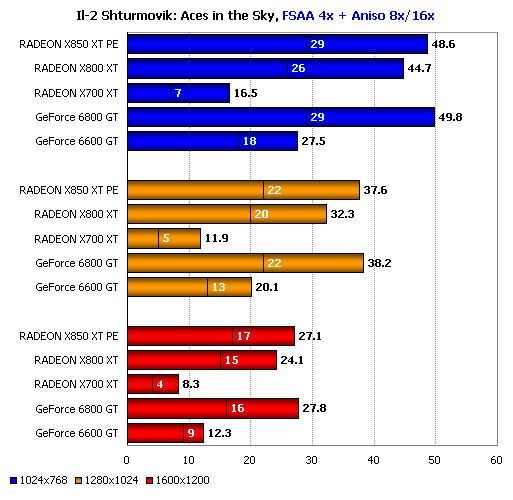
In Eye Candy mode the RADEON X850 XT Platinum Edition and GeForce 6800 GT demonstrate the same results at all resolutions, most likely due to the insufficient power of the microprocessor. RADEON X800 XT lags behind them a little.
Game Tests: Lock On
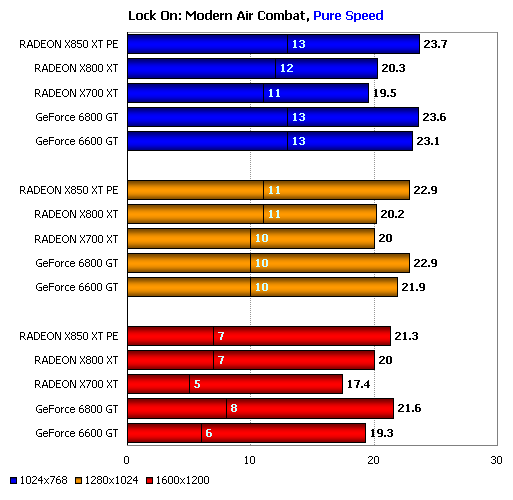
Lock On does not use complex pixel shaders, however, it is extremely demanding on the hardware in the mode of maximum graphics quality. Rarely does a video adapter demonstrate more than 20 frames per second in this mode. Here the GeForce 6800 GT and RADEON X850 XT Platinum Edition are also on a par, while the RADEON X800 XT lags behind them a little.
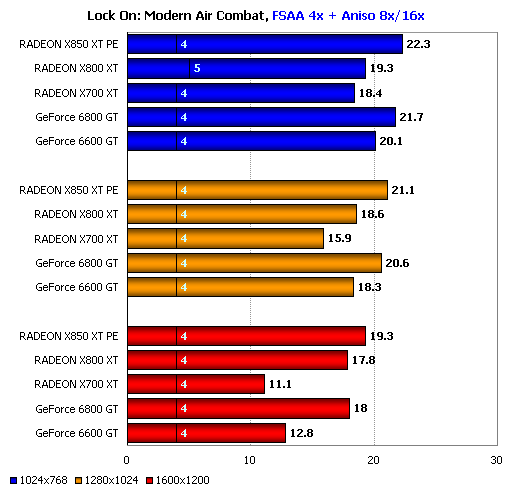
A similar picture is observed when full-screen anti-aliasing and anisotropic filtering are enabled at the same time.
Game Tests: Colin McRae Rally 04
Colin McRae Rally 04 is replete with pixel shaders. As a result, the game prefers video adapters with the architecture developed by ATI Technologies.
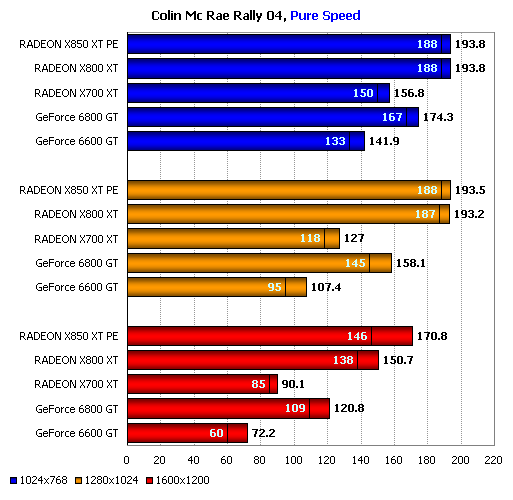
In the first two resolutions the older RADEON models demonstrate the same result, since they reach the performance ceiling, but at 1600×1200 the difference between them is already clearly distinguishable, and the RADEON X850 XT Platinum Edition is noticeably ahead of the RADEON X800 XT.
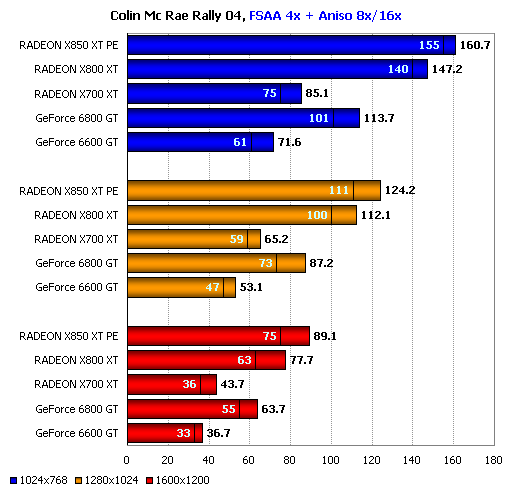
In the mode with activated FSAA and anisotropy, ATI cards are again leading. The advantage of RADEON X850 XT Platinum Edition over RADEON X800 XT here is also quite significant – about 10%.
Game tests: Command & Conquer Generals: Zero Hour
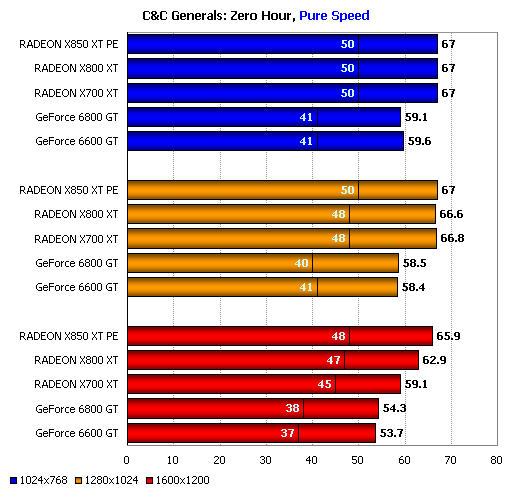
In this game, all ATI cards show the same results as NVIDIA cards, however, for the latter the performance ceiling is for some reason lower. In any case, no useful information can be extracted from this game in pure performance mode – performance is not limited by their performance, but by the speed of the CPU and the quality of the drivers.
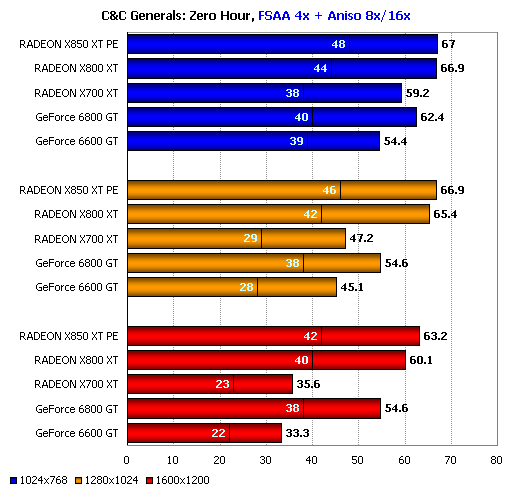
In eye candy mode, the difference is visible, however, only in high resolutions. In this case, RADEON X800 XT and RADEON X800 XT Platinum Edition win again. The performance difference between the two cards is miniscule.
Game Tests: Perimeter
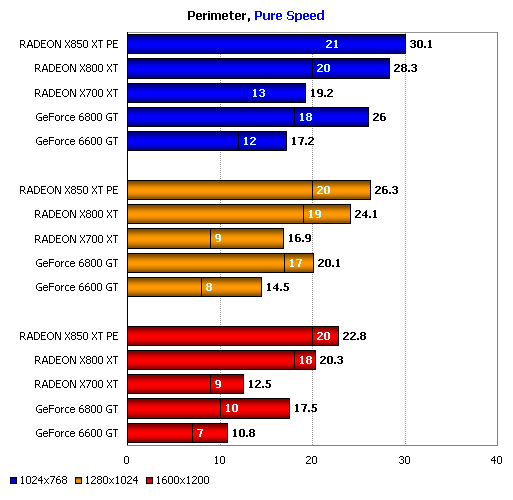
Perimeter is a very difficult and demanding game; she prefers cards with high processing speed pixel shaders. The best results in it are demonstrated by ATI cards, and in this case it happened again – the older RADEON models won. The advantage of the RADEON X850 Platinum Edition over the RADEON X800 XT is quite noticeable, considering the very low fps values in general.
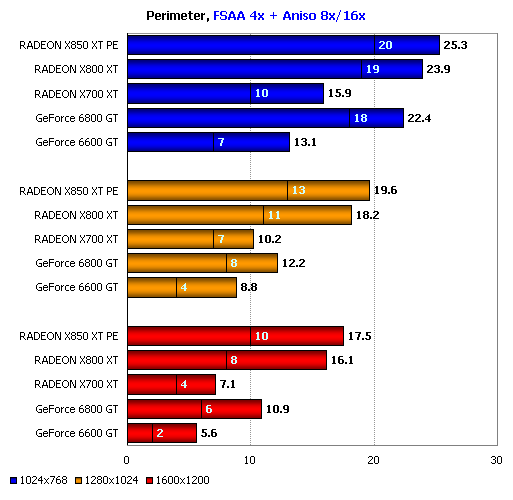
When the full-screen anti-aliasing and anisotropic filtering mode is enabled, nothing special happens – the speed, in general, drops, but the overall picture remains unchanged – RADEON X850 XT Platinum Edition and RADEON X800 XT are leading.
Semi-synthetic tests: Aquamark3
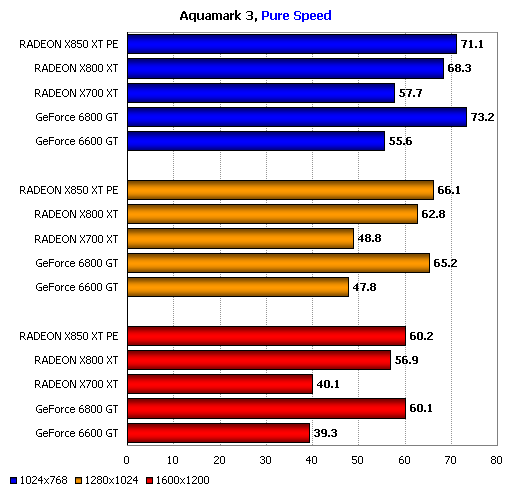
Aquamark3 features complex geometry and a very high overdraw ratio, as well as a small number of complex pixel shaders. Due to these peculiarities, NVIDIA cards demonstrate the best results in this test. Nevertheless, in this case, the GeForce 6800 GT has to share the first place with the RADEON X850 XT Platinum Edition.
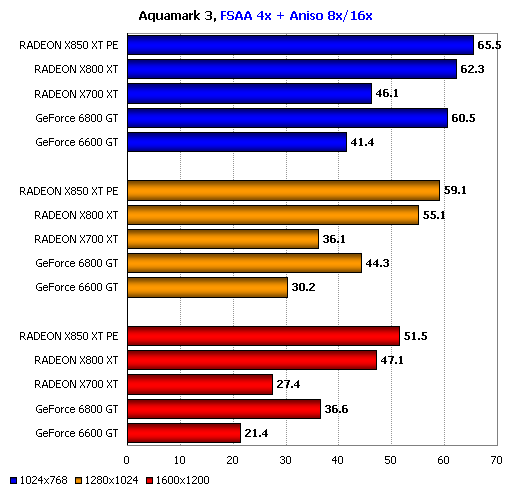
As often happens, ATI cards reveal their full potential in the mode with enabled antialiasing of the entire scene and anisotropic filtering. So it happened here too – both senior RADEONs became winners, which was helped a lot by the HyperZ HD technology.
Synthetic benchmarks: Futuremark 3DMark03
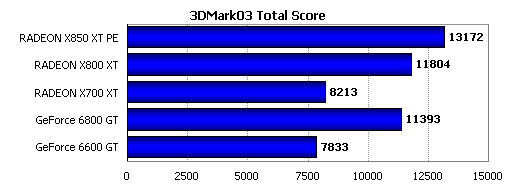
Not so long ago, the 10,000 3DMark03 score was considered a huge achievement, but today’s high-performance graphics adapters easily achieve this result. Moreover, the new RADEON X850 XT Platinum Edition easily surpasses the 13,000 points mark without any tweaks or overclocking. Let’s consider what this result is composed of.
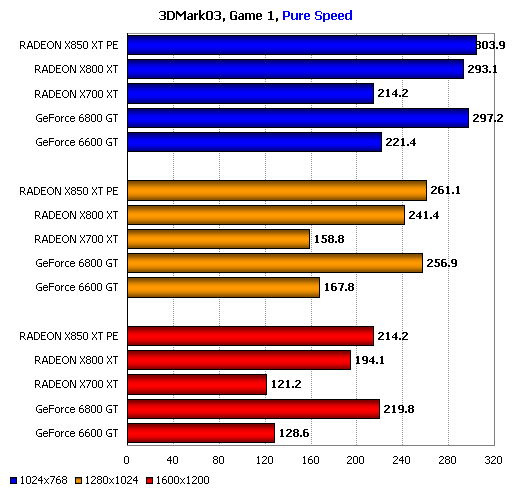
The first gaming test is quite simple, since it lacks any modern technologies and uses only DirectX 7 capabilities. Usually NVIDIA cards feel the best in it, however, this time the GeForce 6800 GT has a competitor – ATI RADEON X850 XT Platinum Edition, thanks to the increased frequencies, demonstrates the same results.
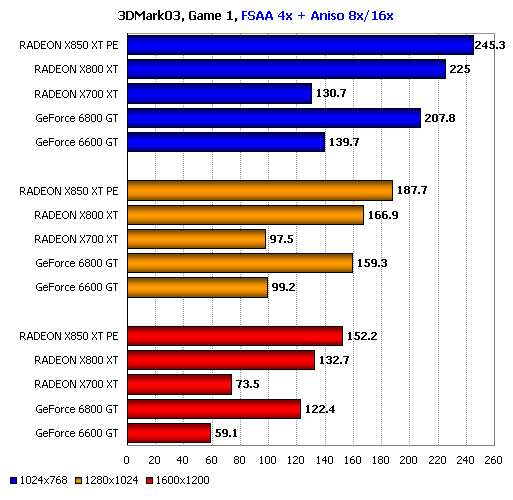
When the full-screen anti-aliasing and anisotropic filtering mode is enabled, the advantage goes to ATI cards – in this mode the GeForce 6800 GT lags behind both the RADEON X800 XT and the RADEON X850 XT Platinum Edition. In both cases, the difference between these video adapters is noticeable, however, it is not too great – 11-20 fps, while the overall performance is about 150-300 fps.
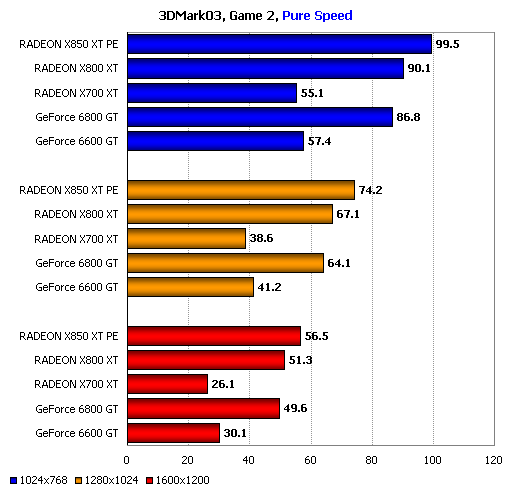
The second gaming test can also be called “NVIDIA territory”, however, the RADEON X850 XT Platinum Edition demonstrates excellent performance here too, outperforming the GeForce 6800 GT. Of course, it is incorrect to compare these products, since they belong to different price classes, but we did not have a GeForce 6800 Ultra in the PCI Express version at our disposal, and the existing copy of the GeForce 6800 refused to overclock at all.
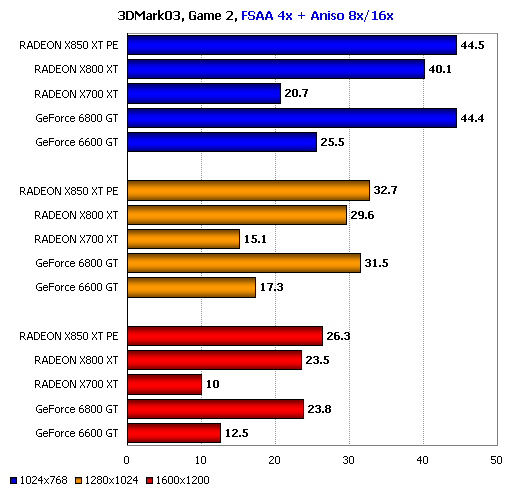
In Eye Candy mode the GeForce 6800 Ultra performed more confidently, slightly outperforming the RADEON X800 XT, however, the RADEON X850 XT Platinum Edition remained in the lead.
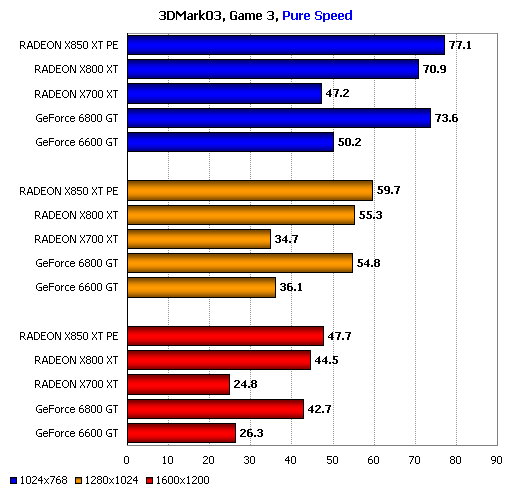
The third gaming test is very similar to the second – the RADEON X850 XT Platinum Edition again took the first place, and the RADEON X800 XT and GeForce 6800 GT shared the second place.
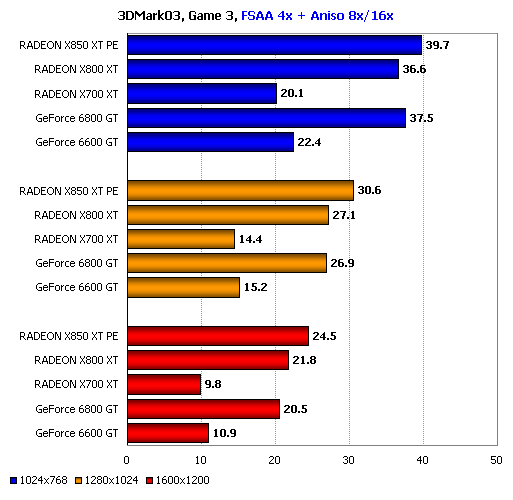
The picture is exactly the same in the Eye Candy mode.
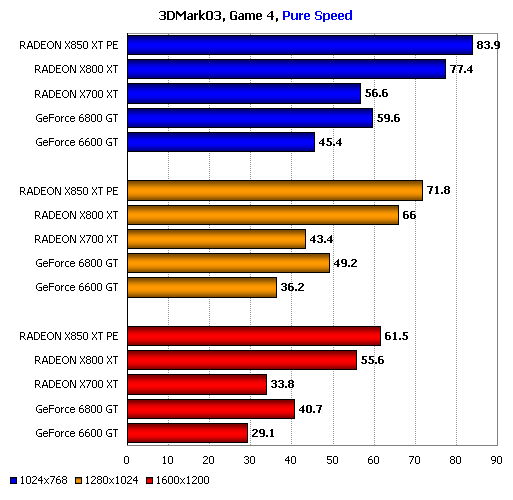
The fourth gaming test, on the other hand, is “ATI’s territory”, since it uses complex pixel shaders. The advantage of RADEON X8x0 cards over GeForce 6800 GT is simply stunning here.
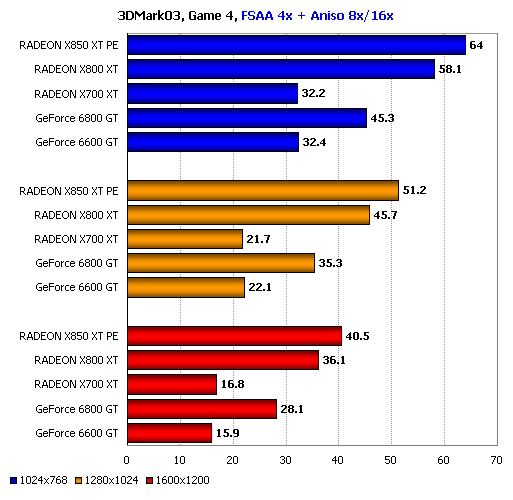
The same can be said about the results obtained with the simultaneous activation of anti-aliasing and anisotropic filtering. The difference between RADEON X850 XT Platinum Edition and RADEON X800 XT again does not exceed 10%. In general, the victory rightfully goes to this particular video adapter.
Synthetic benchmarks: Futuremark 3DMark05
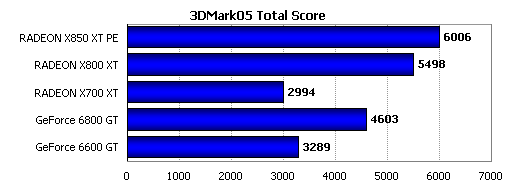
The new version of 3DMark is much more demanding than the old one, and the result of 10,000 points is still unattainable for a single unclocked video adapter. Nevertheless, the RADEON X850 XT Platinum Edition managed to reach 6000 points, which is very, very good. Let’s take a closer look at the results obtained in 3DMark05.
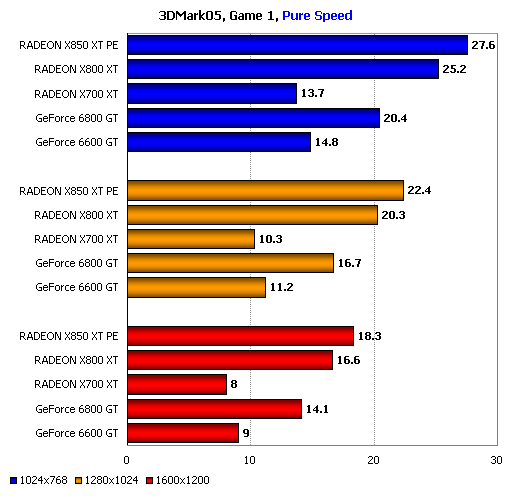
The first gaming test of the 3DMark05 package is a battle scene on the Proxycon space station. The situation is typical for 3D first-person shooters – an interior room, many light sources, many enemies. The scene also uses very complex dynamic shadows. Despite the fact that the GeForce 6800 GT can take advantage of the Shader Model 3.0, the victory goes to the ATI RADEON X800 XT and RADEON X850 Platinum Edition cards, the latter being about 10% faster.
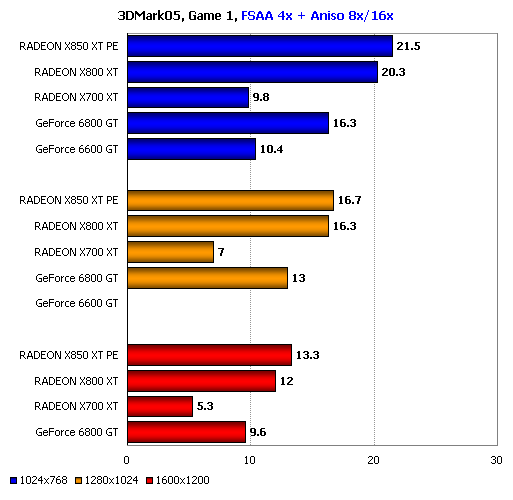
The same cards also win with full-screen anti-aliasing and anisotropic filtering enabled, however, the difference between them in this case is almost imperceptible.
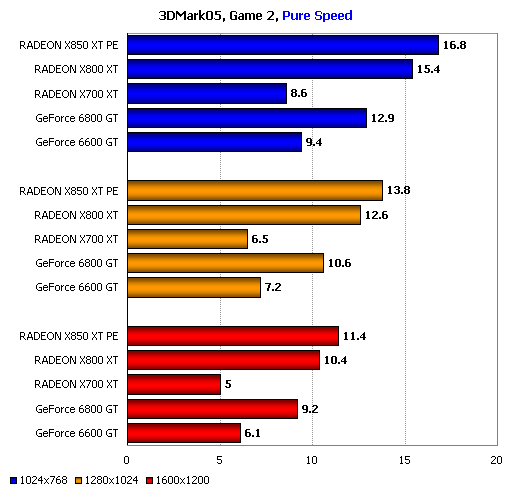
The second game test shows the flight of a firefly in the forest. As a result, there is a lot of vegetation in the scene, which is generated dynamically depending on the position of the camera. This scene also features complex dynamic shadows and lighting effects. Here also ATI RADEON cards are victorious, and the difference between the two older models is again about 8-10%.
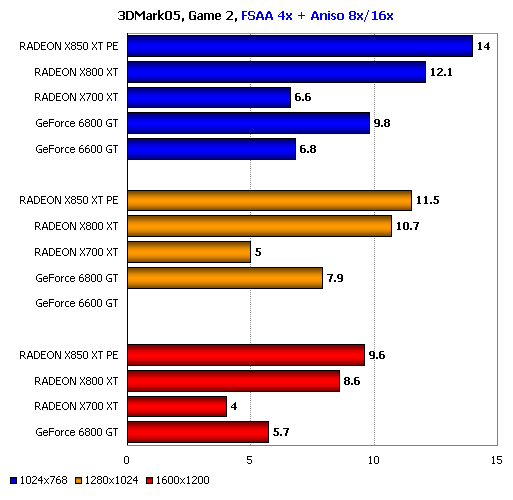
The gap between ATI RADEON X800 / X850 and GeForce 6800 GT widens when full-screen anti-aliasing and anisotropic filtering are enabled. In contrast to the first test, the difference between the RADEON X800 XT and RADEON X850 XT Platinum Edition is also visible in the Eye Candy mode.
There are no results for the GeForce 6600 GT, since this card has only 128 MB of video memory on board, and to work in Eye Candy mode at resolutions higher than 1024×768, 3DMark05 requires 256 MB of video memory, at least on the PCI Expess platform.
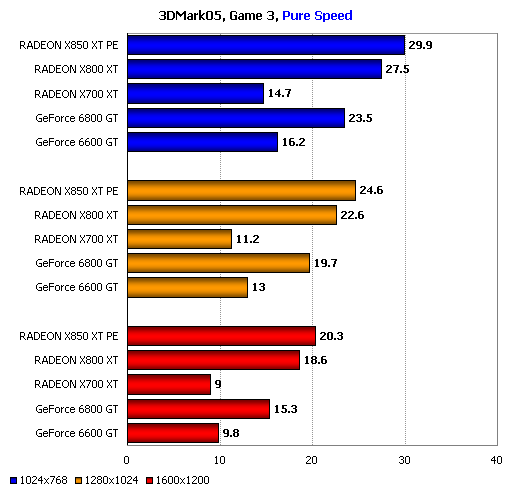
The third gaming test included in 3DMark05 is probably, if not the most beautiful, then the most spectacular for sure. The scene shows the flight of the airship in the canyon. Under the airship, there is a vast water surface, under which real monsters are hiding. The most difficult objects here are the canyon walls, as well as the water surface. The rocks are rendered with a very sophisticated pixel shader and the water uses depth fog to make it look even more realistic. There is only one light source here – the sun, however, the shadows are no less difficult here than in the two previous tests, since the action takes place in an open space. In this test, the victory again goes to cards from ATI Technologies.
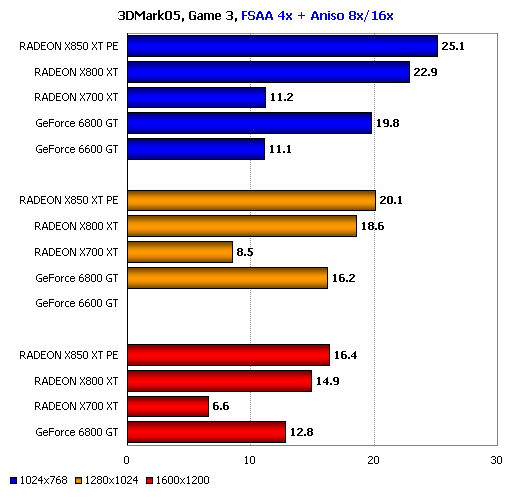
The situation is exactly the same when the full-screen anti-aliasing and anisotropic filtering are enabled, but do not forget that it is not quite correct to compare the RADEON X850 XT Platinum Edition with the GeForce 6800 GT. On the whole, as in the case of 3DMark03, the victory of the new video adapter from ATI Technologies looks quite deserved.
conclusions
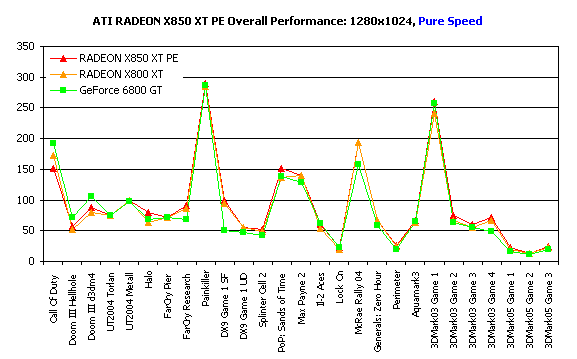
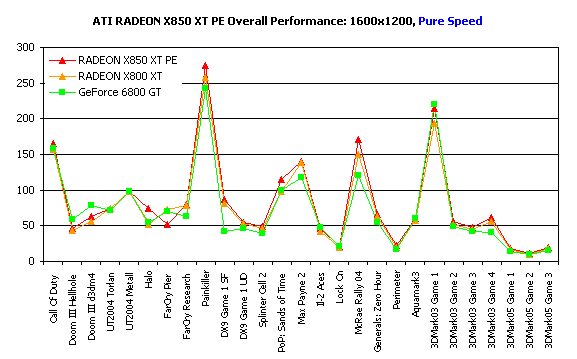
Since the RADEON X850 XT Platinum Edition is not a truly new product, but only an improved RADEON X800 XT Platinum Edition with higher frequencies and the potential for more confident overclocking, it can hardly be said about the product as something really unusual.
ATI RADEON X850 XT PE, like any other product based on the R480 chip, has incorporated all the positive and negative aspects of the ATI RADEON X800 graphics architecture. Possessing extremely efficient pixel and vertex processors, the RADEON X850 XT Platinum Edition easily outperforms its competitor in the face of the GeForce 6800 Ultra in the latest games like FarCry, Half-Life 2, which means it can count on victory in future games with heavy use of DirectX 9.0 effects … However, the lack of technologies like NVIDIA UltraShadow and effective texturing units does not allow the new product to seize the crown of the championship in the Doom III game.
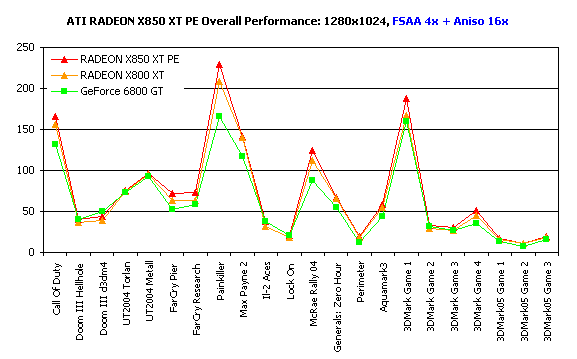
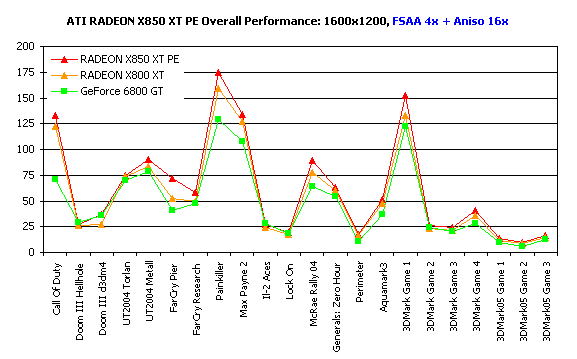
There are no obvious drawbacks in the RADEON X850 XT Platinum Edition, except for the rather bulky dual-slot cooling system. Certain advantages over the previous top-end solution, RADEON X800 XT Platinum Edition, the new product also has, if you do not attach much importance slightly increased frequencies and new technology for dynamic overclocking OVERDRIVE 3. Where more interest is the availability of graphics solutions RADEON X850 XT ordinary customers (at at least when retail buyers are seriously interested in PCI Express x16 accelerators). If there were a number of problems with the RADEON X800 family, what will happen to the RADEON X850? Only time will tell.





